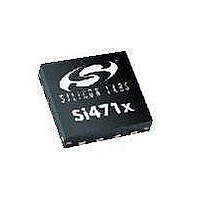Si4711-A20-GM Silicon Laboratories Inc, Si4711-A20-GM Datasheet - Page 22

Si4711-A20-GM
Manufacturer Part Number
Si4711-A20-GM
Description
RF Transmitter Broadcast FM Radio Trns w/RDS/RBDS
Manufacturer
Silicon Laboratories Inc
Datasheet
1.SI4711-A20-GM.pdf
(38 pages)
Specifications of Si4711-A20-GM
Lead Free Status / RoHS Status
Lead free / RoHS Compliant
Si4710/11-A20
5.4. Line Input
The Si4710/11 provides left and right channel line inputs
(LIN and RIN). The inputs are high-impedance and low-
capacitance, suited to receiving line level signals from
external audio baseband processors. Both line inputs
are low-noise inputs with programmable attenuation.
Passive and active anti-aliasing filters are incorporated
to prevent high frequencies from aliasing into the audio
band and degrading performance.
To ensure optimal audio performance, the Si4710/11
has a TX_LINE_INPUT_LEVEL property that allows the
user to specify the peak amplitude of the analog input
(LILEVEL[9:0])
deviation level programmed in the audio deviation
property, TX_AUDIO_DEVIATION. A corresponding line
input attenuation code, LIATTEN[1:0], is also selected
by the expected peak amplitude level. Table 14 shows
the line attenuation codes.
The line attenuation code is chosen by picking the
lowest Peak Input Voltage in Table 14 that is just above
the expected peak input voltage coming from the audio
baseband processor. For example, if the expected peak
input voltage from the audio baseband processor is
400 mV, the user chooses LIATTEN[1:0] = 10 since the
Peak Input Voltage of 416 mV associated with
LIATTEN[1:0] = 10 is just greater than the expected
peak input voltage of 400 mV. The user also enters
400 mV into the LILEVEL[9:0] to associate this input
level to the maximum frequency deviation level
programmed into the audio deviation property. Note that
selecting a particular value of LIATTEN[1:0] changes
the input resistance of the LIN and RIN pins. This
feature is used for cases where the expected peak input
level exceeds the maximum input level of the LIN and
RIN pins.
The maximum analog input level is 636 mVpK. If the
analog input level from the audio baseband processor
exceeds this voltage, series resistors must be inserted
in front of the LIN and RIN pins to attenuate the voltage
such that it is within the allowable operating range. For
example, if the audio baseband's expected peak
22
LIATTEN[1:0]
00
01
10
11
Table 14. Line Attenuation Codes
required
Voltage [mV]
Peak Input
190
301
416
636
to
reach
Resistance [k]
RIN/LIN Input
the
396
100
74
60
maximum
Rev. 1.1
amplitude is 900 mV and the V
the designer can use 30 k series resistors in front of
the LIN and RIN pins and select LIATTEN[1:0] = 11. The
resulting expected peak input voltage at the LIN/RIN
pins is 600 mV, since this is just a voltage divider
between the LIN/RIN input resistance (see Table 14,
60 k for this example) and the external resistor. Note
that the Peak Input Voltage corresponding to the chosen
LIATTEN[1:0] code still needs to satisfy the condition of
being just greater than the attenuated voltage. In this
example, a line attenuation code of LIATTEN[1:0] = 11
has a Peak Input Voltage of 636 mV, which is just
greater than the expected peak attenuated voltage of
600 mV. Also, the expected peak attenuated voltage is
entered into the LILEVEL[9:0] parameter. Again, in this
example, 600 mV is entered into LILVEVEL[9:0]. This
example shows one possible solution, but many other
solutions exist. The optimal solution is to apply the
largest possible voltage to the LIN and RIN pins for
signal-to-noise
resistor values may limit the choices.
Note that the TX_LINE_INPUT_LEVEL parameter will
affect the high-pass filter characteristics of the ac-
coupling capacitors and the resistance of the audio
inputs.
The Si4710/11 has a programmable low audio level and
high audio level indicators that allows the user to
selectively enable and disable the carrier based on the
presence of audio content. The TX_ASQ_LEVEL_LOW
and TX_ASQ_LEVEL_HIGH parameters set the low
level and high level thresholds in dBFS, respectively.
The time required for the audio level to be below the low
threshold is set with the TX_ASQ_DURATION_LOW
parameter, and similarly, the time required for the audio
level to be above the high threshold is set with the
TX_ASQ_DURATION_HIGH parameter.
5.5. Stereo Audio Processing
The multiplexed (MPX) standard was developed in 1961
and is used worldwide for FM transmission. Today's
MPX signal format consists of left + right (L+R) audio,
left – right (L–R) audio, a 19 kHz pilot tone, and
RDS/RBDS data as shown in Figure 17.
considerations;
IO
supply voltage is 1.8 V,
however,
practical










